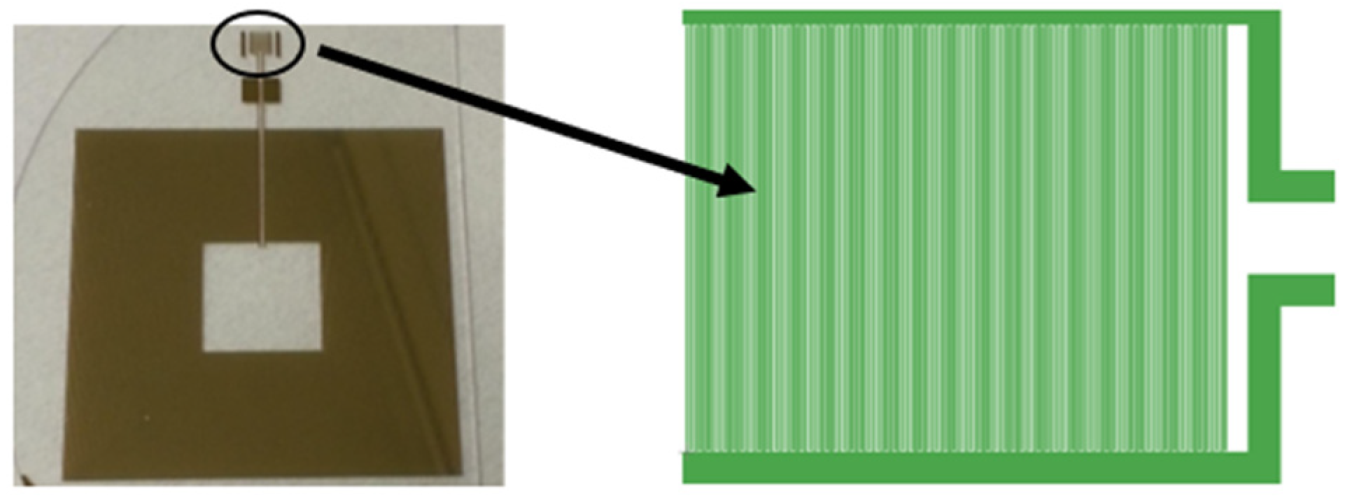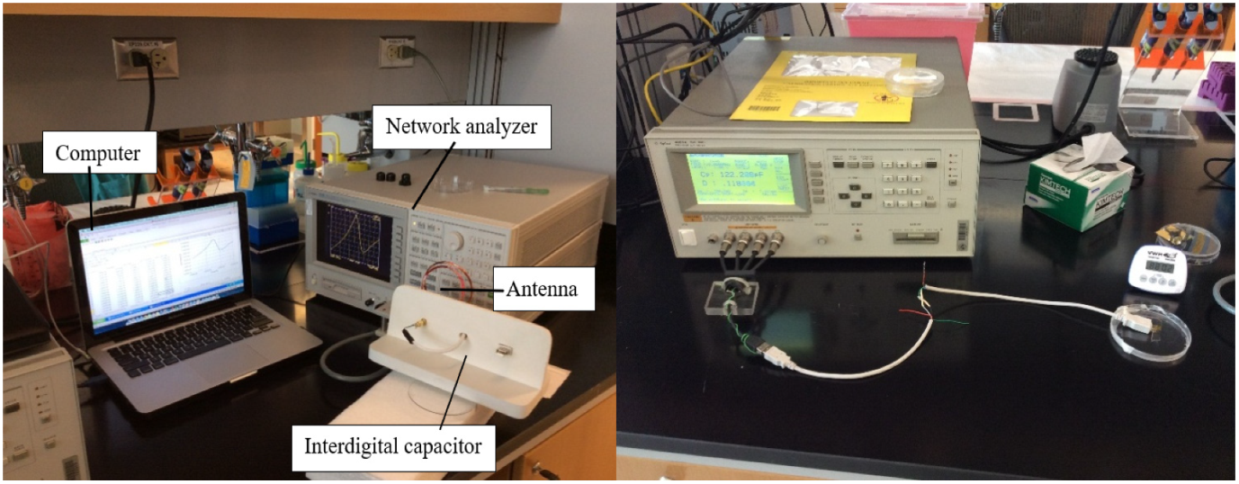Design and Characterization of a Passive Wireless DNA Sensor †
Abstract
:1. Introduction
2. Principle and Design
2.1. Interdigital Capacitor Design
2.2. Spiral Inductor Design
2.3. Electrical Model of Resonant Circuit
3. Experiment Procedure
3.1. Material and Preparation
3.2. Experiment Setup and Procedure
- Setup and Calibration: The experiment setup is presented in Figure 3. Before introducing specimen, the 0 S, 0 Ω, and 50 Ω terminations in the calibration kit are required. In respect to LCR meter, the open and short circuit test were performed leaving an open or short connection between the IDC connection station docking terminals for eliminating stray capacitance.
- Measure bare electrodes: The frequency peak corresponding to clean bare electrodes was measured as a baseline of this experiments.
- Measurement of ssDNA: a drop of 5 mM ssDNA solution was deposited on the interdigital part enclosed by insulated rubber tape to prevent connection between two electrodes from presence of solution, then kept in a clean petri dish for 20 h. After of the period is complete, the electrode was rinsed with preparative buffer and dried with a nitrogen stream for eliminating the excess unattached to electrodes. The frequency peak was observed in network analyzer screen and the capacitance obtained by LCR meter.
- Measurement of 5 mM ssDNA with non-complementary target: non-complementary strand of DNA was introduced and remain 3 h. followed by the cleaning with buffer and nitrogen measurement was taken. The measurement is aimed at being a contrast experiment for the DNA hybridization process.
- Measurement of 5 mM ssDNA with complementary target: this step would also take 3 h and same cleaning task before measurement.
4. Results and Discuss
4.1. Bare IDC Capacitance Result
4.2. Immobilization of ssDNA
4.3. Hybridization of the Complementary Strand
4.4. Result Discussion
5. Conclusions
- Improve the IDC DNA sensor with higher sensitivity, linearity, and minimized sensor size;
- Extend the communication distance of the DNA sensor;
- Develop a cost-effective way to read out the data transformed from proposed LC circuit, such as applying RFID technology;
Supplementary Materials
Author Contributions
Funding
Institutional Review Board Statement
Informed Consent Statement
Data Availability Statement
Acknowledgments
Conflicts of Interest
References
- Millan, K.M.; Mikkelsen, S.R. Sequence-selective biosensor for DNA based on electroactive hybridization indicators. Anal. Chem. 1993, 65, 2317–2323. [Google Scholar] [CrossRef] [PubMed]
- Daniels, J.S.; Pourmand, N. Label-Free Impedance Biosensors: Opportunities and Challenges. Electroanal. 2007, 19, 1239–1257. [Google Scholar] [CrossRef] [PubMed]
- Lao, R.; Song, S.; Wu, H.; Wang, L.; Zhang, Z.; He, A.L.; Fan, C. Electrochemical Interrogation of DNA Monolayers on Gold Surfaces. Anal. Chem. 2005, 77, 6475–6480. [Google Scholar] [CrossRef] [PubMed]
- Albers, J.; Grunwald, T.; Nebling, E.; Piechotta, G.; Hintsche, R. Electrical biochip technology?a tool for microarrays and continuous monitoring. Anal. Bioanal. Chem. 2003, 377, 521–527. [Google Scholar] [CrossRef] [PubMed]
- Clack, N.G.; Salaita, K.; Groves, J.T. Electrostatic readout of DNA microarrays with charged microspheres. Nat. Biotechnol. 2008, 26, 825–830. [Google Scholar] [CrossRef] [PubMed] [Green Version]
- Goodrich, T.T.; Lee, H.J.; Corn, R. Enzymatically Amplified Surface Plasmon Resonance Imaging Method Using RNase H and RNA Microarrays for the Ultrasensitive Detection of Nucleic Acids. Anal. Chem. 2004, 76, 6173–6178. [Google Scholar] [CrossRef] [PubMed]
- Cao, Y.C.; Jin, R.; Mirkin, C.A. Nanoparticles with Raman Spectroscopic Fingerprints for DNA and RNA Detection. Science 2002, 297, 1536–1540. [Google Scholar] [CrossRef] [PubMed] [Green Version]
- Bandiera, L.; Cellere, G.; Cagnin, S.; De Toni, A.; Zanoni, E.; Lanfranchi, G.; Lorenzelli, L. A fully electronic sensor for the measurement of cDNA hybridization kinetics. Biosens. Bioelectron. 2007, 22, 2108–2114. [Google Scholar] [CrossRef] [PubMed]
- Drummond, T.G.; Hill, M.G.; Barton, J.K. Electrochemical DNA sensors. Nat. Biotechnol. 2003, 21, 1192–1199. [Google Scholar] [CrossRef] [PubMed] [Green Version]
- Vo-Dinh, T.; Alarie, J.P.; Isola, N.; Landis, D.; Wintenberg, A.L.; Ericson, M.N. DNA Biochip Using a Phototransistor Integrated Circuit. Anal. Chem. 1999, 71, 358–363. [Google Scholar] [CrossRef] [PubMed]
- Liu, T.; Tang, J.; Han, M.; Jiang, L. A novel microgravimetric DNA sensor with high sensitivity. Biochem. Biophys. Res. Commun. 2003, 304, 98–100. [Google Scholar] [CrossRef]
- Rivera-Gandía, J.; Maldonado, M.D.M.; De La Torre-Meléndez, Y.; Ortiz-Quiles, E.O.; Vargas-Barbosa, N.M.; Cabrera, C.R. Electrochemical Capacitance DNA Sensing at Hairpin-Modified Au Electrodes. J. Sensors 2011, 2011, 1–6. [Google Scholar] [CrossRef] [Green Version]
- Sasindran, S.J.; Torrelles, J.B. Mycobacterium Tuberculosis Infection and Inflammation: What is Beneficial for the Host and for the Bacterium? Front. Microbiol. 2011, 2, 2. [Google Scholar] [CrossRef] [PubMed] [Green Version]
- Xu, H.; Jia, Y. The novel design of Interdigital capacitor and Planar Inductor. Unpublished work. 2021.






| Parameter | Symbol | Value |
|---|---|---|
| Finger Width | WC | 0.01 mm |
| Finger Gaps | GC | 0.01 mm |
| Finger Length | LC | 2 mm |
| Number of Fingers | NC | 130 |
| The Thickness of Finger | t | 0.002 mm |
Publisher’s Note: MDPI stays neutral with regard to jurisdictional claims in published maps and institutional affiliations. |
© 2021 by the authors. Licensee MDPI, Basel, Switzerland. This article is an open access article distributed under the terms and conditions of the Creative Commons Attribution (CC BY) license (https://creativecommons.org/licenses/by/4.0/).
Share and Cite
Xu, H.; Jia, Y.; Cunci, L. Design and Characterization of a Passive Wireless DNA Sensor. Eng. Proc. 2021, 10, 39. https://doi.org/10.3390/ecsa-8-11261
Xu H, Jia Y, Cunci L. Design and Characterization of a Passive Wireless DNA Sensor. Engineering Proceedings. 2021; 10(1):39. https://doi.org/10.3390/ecsa-8-11261
Chicago/Turabian StyleXu, Haibo, Yi Jia, and Lisandro Cunci. 2021. "Design and Characterization of a Passive Wireless DNA Sensor" Engineering Proceedings 10, no. 1: 39. https://doi.org/10.3390/ecsa-8-11261
APA StyleXu, H., Jia, Y., & Cunci, L. (2021). Design and Characterization of a Passive Wireless DNA Sensor. Engineering Proceedings, 10(1), 39. https://doi.org/10.3390/ecsa-8-11261






